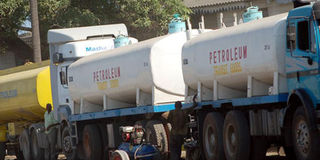Kenya Pipeline records fuel losses worth billions stolen by syndicates

Petroleum tankers parked in Changamwe, Mombasa County. Adulteration of fuel has been a huge headache for the Energy Regulatory Commission. FILE PHOTO | NATION MEDIA GROUP
What you need to know:
- Data show that over 27 million litres of the product has mysteriously been lost from January 2014 to December 2016.
- The Sh48 billion pipeline from Mombasa is almost complete with its flow rate expected to be at one million litres per hour.
The suspension of a senior Kenya Pipeline Company official last week concerning the loss of 300,000 litres of fuel has blown the lid off the operations of a suspected powerful cartel.
Investigations by the Sunday Nation reveal that millions of litres of fuel could have been sneaked out of Kenya Pipeline depots by a criminal network involving staff and influential individuals.
The stolen fuel is eventually registered as “pipeline losses” and the oil marketers compensated through a formula that finally places the burden on the consumers buying at the petrol stations.
This fuel then ends up in the market to undercut the legitimate dealers and sometimes support the adulteration cartel that mixes diesel or petrol with kerosene.
The method is said to be among the key channels through which the product is stolen as KPC staff illegally allocate fuel designated to one oil marketer to another. The product is then registered as lost.
The theft is emboldened by a contractual clause between the oil marketers and the state agency that allows for up to 0.25 per cent product loss within the pipeline system, hence providing a comfortable cover to attribute the millions of litres stolen.
With KPC passing 700,000 litres of product per hour through the Mombasa-Nairobi pipeline, those involved know too well that at the end of the month, they are allowed to “lose” 1.2 million litres through the “pipeline losses”. They strive to stick to just that.
MARKETERS PROTEST
Data from the gains and losses now show that over 27 million litres of the product has mysteriously been lost from January 2014 to December 2016, leaving the oil marketers alarmed.
This is worth more than Sh2.5 billion, underlining the value of the fuel siphoning networks that stretch far and wide.
The oil marketers through their supply co-ordination secretariat, Supplycor Kenya Limited, have written to KPC in protest as the loss figures raise eyebrows with sometimes hundreds of thousands of litres lost overnight.
“We are faced with an incredible loss of 5.4 million litres within a six-month period. This product has the equivalent street value of about Sh470 million at current fuel pump prices.
"OMC (oil marketing companies) rely on Kenya Pipeline as a safe bank for fuel stocks whilst in transit to consumers. The unexplained fuel stock loss in the pipeline in now a major cause of concern and alarm.
"We seek and appeal for your intervention to stem the tide of fuel stock loss that is significantly eroding value in Kenya’s oil marketer industry,” read a letter written last month addressed to Petroleum Principal Secretary Andrew Kamau and KPC Managing Director Joe Sang.
In one instance, the oil marketers had even physically verified stock at KPC on the evening of June 30 last year and recorded the stock levels.
But the next morning there was a mysterious 268,000-litre difference in the system.
The KPC stock control team is said to have avoided industry meetings where issues relating to the overstated losses would be discussed according to another complaint letter Supplycor wrote in November 2016.
AUDIT LAUNCHED
A similar scheme was used to channel fuel to Triton Oil Company in 2008, where KPC staff allowed the company, associated with fugitive tycoon Yagnesh Devani, to collect oil valued at Sh7.6 billion and sell it without permission of the financiers.
In the wake of the fuel shortage witnessed in 2008 and following complaints by oil marketers and financiers, KPC ordered an internal audit of oil stocks in its systems.
The audit revealed that stocks amounting to 126.4 million litres were irregularly released to Triton between November 2007 and November 2008.
Rogue KPC staff with access to the stock management system are said to have been taking advantage of the allowed internal borrowing of product among the oil marketers to channel product illegally to other players in exchange for fat kickbacks and shares of the proceeds.
But it is the consumers who eventually pay for this at the pump.
In another twist that demonstrates the reality of this method being used to steal fuel from KPC depots, the state agency on Friday suspended stock borrowing among the oil marketers through the KPC systems.
KEROSENE SHAMBAS
In a letter to various chief executives of oil marketers, the KPC managing director said the borrowing window had been abused.
Sources within KPC say the silent siphoning of product has remained largely unnoticed because the oil marketers are tied by the contract and still end up being compensated.
Done deep in the night, the product is pumped to one of the depots located on Nanyuki Road via the direct pipes into KPC depots and ferried in trucks to the mainstream market, exported or end up at the illegal adulteration sites commonly referred to as “shambas”.
Of even bigger concern is the latest increased trends where kerosene losses have been increasing with a big blow on the government efforts to raise tax on the product to discourage adulteration.
In the two months before the September 2016 crackdown on adulterated fuel, over 400,000 litres of kerosene was registered “lost” in the system pointing to a well-established source of the product mixed with diesel to maximise profits.
The adulteration now threatens Kenya’s fuel market as countries in the region look elsewhere for supply.
Adulteration has been a huge headache for the Energy Regulatory Commission with efforts to deal with the cartel through regular testing of product, prosecution of dealers and closure of the “shambas” suffering a big blow as the suspected cartel appears to shift focus to KPC depots.
NEW PIPELINE
It also remains mysterious how fuel of this magnitude can be attributed to mere pipeline losses, which include evaporation and remnant in the pipes.
In fact, one truck carrying at most 30,000 litres of fuel means the six months loss of 5.4 million litres is 180 trucks or at least one fully loaded truck per day.
“This should have formed a whole lake of product even in the event of a major spillage, which we have not heard of. We end up competing with the cartel in the market where they sell the same fuel they have stolen from us. Worse still, the adulteration in those ‘shambas’ only spoil our reputation and we can’t sell much beyond our borders.
"This is a big scum and let me tell you the scale will even be bigger with the new pipeline from Mombasa,” an oil marketer told Sunday Nation in confidence.
The Sh48 billion pipeline is almost complete with its flow rate expected to be at one million litres per hour.
Kenya hopes to use the boosted rate by the new 20 inch diameter pipeline to supply to the export market of Uganda and Rwanda, which now stands at 3.5 billion litres.





